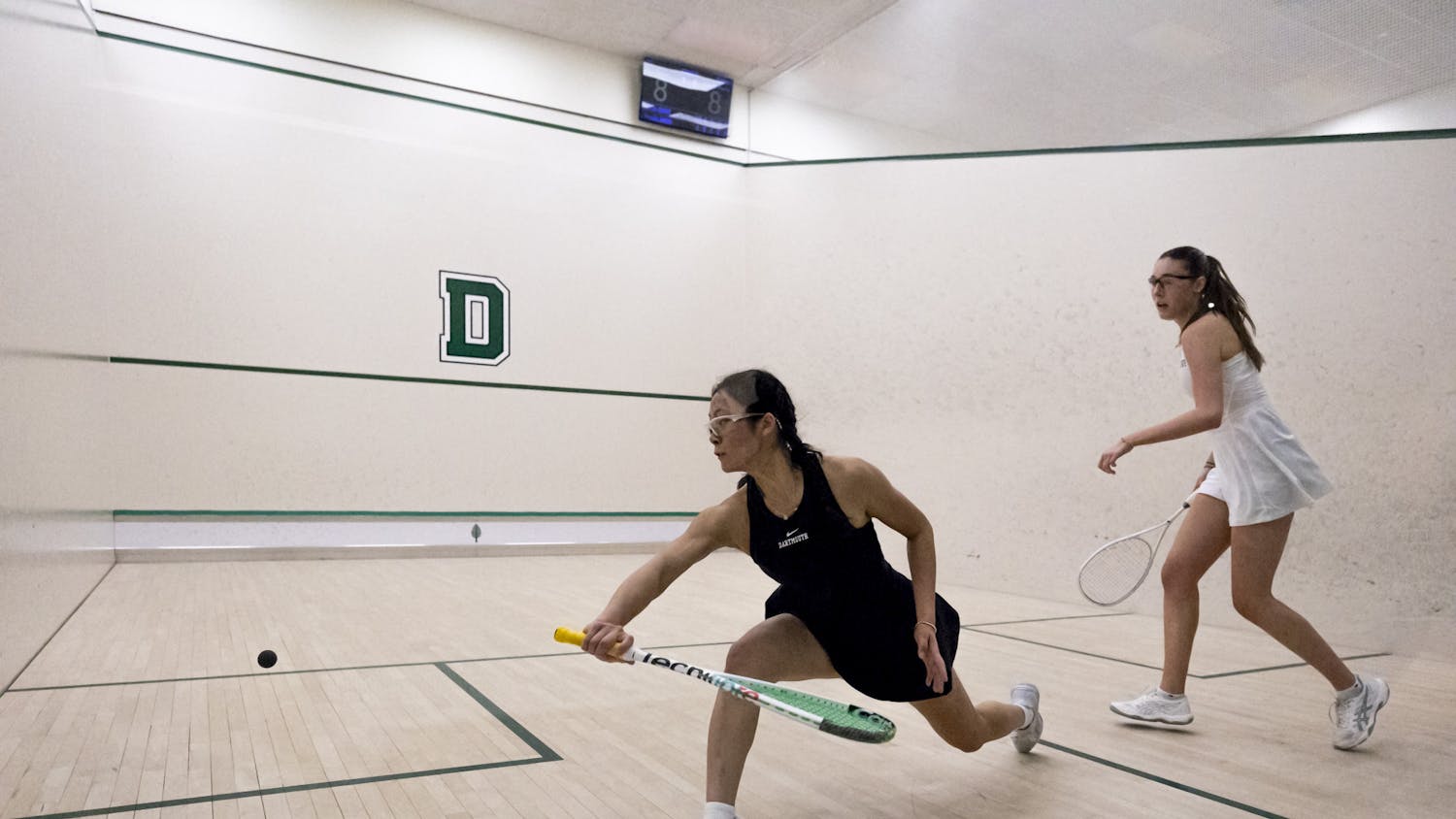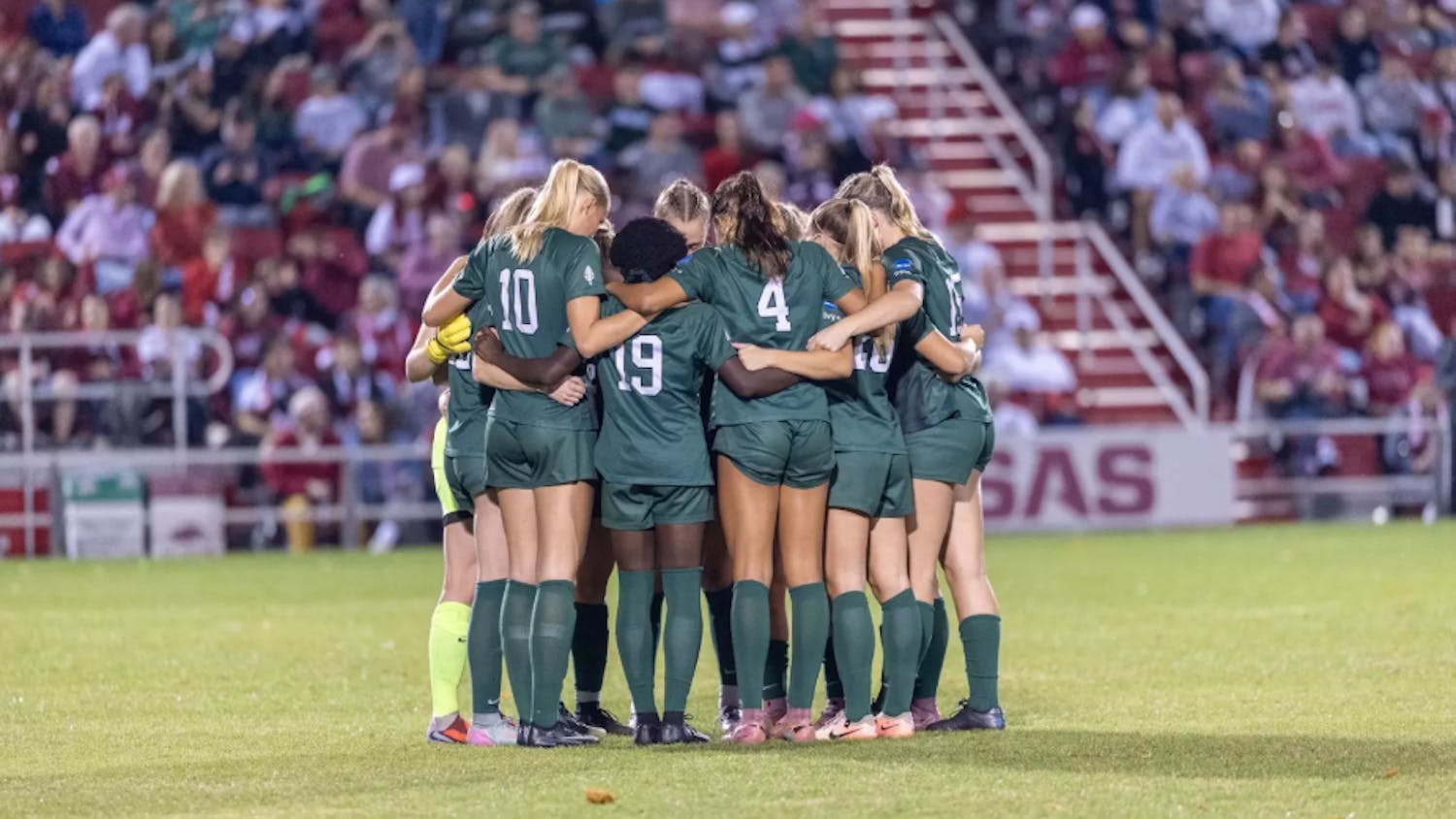Performing synchronized dance moves and hoisting up members in one-man stunts, the Dartmouth cheerleading squad has become a staple at home football and basketball games.
Despite their strong showings this year, some students today still see the cheerleaders as a side show to the actual game.
Up until the last few decades, however, cheerleaders at Dartmouth played a large role in bolstering the Big Green's reputation.
In the past, selected sons, and later daughters, of Dartmouth directed the cheers of the undergraduate body at sporting events, representing the Big Green at home and away.
Appointed first through popular election by the classes during the first quarter of the 20th century and then through tryout, Dartmouth's cheerleaders embodied the best spirit the College had to offer.
By their prominence, the students were counted on to arouse enthusiasm that was at times lacking during games.
The squad members used any means possible to stir up a response from the audience, from traditional chants and fight songs, to synchronized acrobatics along the field.
They sometimes donned stereotypical Native American costumes during critical football games, a practice suspended in 1969 with the College's decision to discontinue use of the "Indian" symbol.
The Big Green cheerleaders undertook a year-round effort to assure that Dartmouth spirit lived on.
Off the field, the cheerleaders instilled enthusiasm in the freshmen, hosting rallies prior to athletic events in the fall.
The College also entrusted the squad with the teaching of the traditional chants to the incoming classes.
Linda Gridley '82 said that during her time as a cheerleader at Dartmouth, the squad was known for its unique, spontaneous and often humorous attempts at getting the crowd on its feet and bringing out Big Green spirit.
The squad prided itself on periodically wearing outrageous and colorful outfits that drew laughs from the crowds, she said.
"We did a lot more of stuff that would be considered illegal now-a-days," she said. "We would go out and put people on the line and somersault over them in the air. And we would go running around to the tailgate [parties]."
Though more amusing than technical, the Dartmouth cheerleaders' on-field antics stressed the fact that they were committed to their fans.
"Back then, I, for one, couldn't do a cartwheel or the splits, but the crowd still loved us as a squad," Gridley said.
The cheerleading team did not focus on doing everything so perfectly that the audience felt too intimidated to join in, Gridley said.
Cheers were participatory, incorporating the audience in the support the football team.
Formalized rules and national cheerleading entities, however, eventually did away with the wearing of hats, sunglasses and all other non-regulation apparel that distinguished the Big Green cheerleaders from other squads, The Dartmouth reported.
Some critics of cheerleading began looking skeptically at the idea that cheerleading existed solely to generate enthusiasm for sports like football or basketball, and that these sports were, by definition, more important than cheerleading itself.
While the advent of competitive cheerleading attempted to quell the criticism, its inception stirred the age-old argument about what exactly constituted a sport.
This year's Big Green squad now looks to break down long-standing stereotypes about cheerleading by joining in national competitions, according to co-captain Natalie Corrilo '11.
In addition to cheering at football and basketball games, Corrilo said that the squad plans to begin competing at the National Cheerleading Association Championships held in Daytona, Fla., every March.
"All the girls are really excited to start focusing on our team's accomplishments," she said. "Everyone's excited about competing against schools that are known for their cheerleading programs."
Yet, given the nature of competitive cheerleading, Dartmouth still has a lot of ground to cover in order to perform the high-risk routines that distinguish competitive squads from the stereotypical spirit-rousers on the side lines.
With no pads or helmets, little protects cheerleaders from poor landings on the gym floor. The ever-increasing repertoire of precarious stunts and tumbling requires mats as a basic safety measure.
Success at attaining these skills, though, comes with a price tag.
As a club sport, the cheerleading squad receives only $200 per term from the College. The team can then supplement that amount with whatever additional money it can generate through fundraising.
The College's funding alone fails to cover for the cost of even a few small mats, coach Lindsay Davis said.
Despite the team's financial troubles, the Big Green cheerleaders are focusing on the squad's stability by maintaining its current roster, though the team will hold tryouts in the futuer, Corrilo said.
Corrilo said she felt that the diversity of the squad's members and the addition last year of a new coach, Josh Hartman, has enhanced the team's dynamic.
"I definitely feel like our team this year has gotten a lot stronger because we have a new coach," she said. "We also have everything from people who have cheered before and people who have been cheering for practically their entire life."
The Big Green cheerleaders hope to win over any remaining skeptics through a series of progressions in stunting and tumbling, Corrilo said.
She added that the team is also looking to capitalize on the addition of four male cheerleaders on the team in order to bring the squad's skills up to par with those of other competitive teams.
"Last year, we didn't have any guys on the team," she said. "The difference can be seen in the stunting. The girls have to get comfortable with the idea, and the guys, too, have to realize that they'll be put into uncomfortable situations."
An integral part of the team's potential is its youth, as all of the 16 cheerleaders come from the freshman and sophomore classes.
"We have a young team we can actually work with," Corrilo said. "I feel like by the time I'm a senior, we can actually be a force to be reckoned with."
Corrilo added that the team's camaraderie has proved crucial to the team's development this year.
"I feel like this year, we've also grown closer to each other," she said. "Every day after practice we go to dinner and mingle. It's a nice team bonding experience, and it's crucial when so much of what we do is about trust."
Although it is difficult now to predict the outcome of these efforts, the Dartmouth cheerleaders are beginning to take the steps to become more trained and earn more respect from both other athletes and finicky fans.
"It'll take some time to build the group up," Corrilo said. "But every person on the squad is willing to put in the effort, so I'm confident that we'll succeed."



